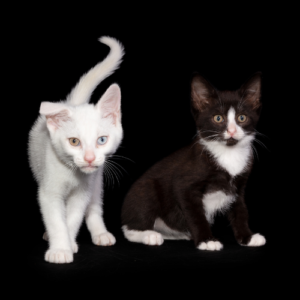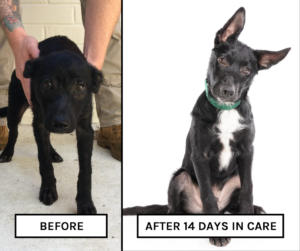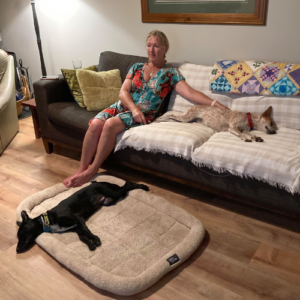Have you ever encountered a deaf cat? It’s possible you may have met one without knowing it! Deaf cats can be just as alert and vibrant as their hearing counterparts, and our kitten Eddie is living proof. Eddie arrived in late November as an 8-week old stray, and following health checks, it became clear he was deaf. Eddie is now available for adoption with his hearing sibling and assistance cat Malcolm. They can’t wait to find a new home together, but first, their new family will need to learn a few things about caring for a deaf cat.
 What causes deafness in cats?
What causes deafness in cats?
Like with humans, cat can lose their hearing as they age, or due to medication side effects or physical illness. However, in Eddie’s case, he has congenital deafness, meaning he has a genetic defect that caused him to be born deaf. Cats with a predominately white coat have the highest rate of congenital deafness.
What type of home is suitable for a deaf cat?
It’s important to provide a deaf cat with a protected indoor environment where they feel safe.
As SDCH Animal Care Manager & Vet Dr Renae Jackson notes, “the outside world is a very dangerous place for a deaf cat, as they can’t hear noises such as dogs, other cats and traffic.” To keep them safe, deaf cat must be kept indoors. They can have a great quality of life indoors, but if you would like to give them the opportunity to explore the outside world, an outdoor cat enclosure can be a great source of enrichment. Most cats can also be trained to use a harness and leash.
Deaf cats can be easily startled, so it’s important to provide safe places where they can survey their surroundings and minimise the risk of surprises. Dr Jackson notes, “high up places are the best, where no one can sneak up on them or accidentally step on them.” As such, it’s a good idea to provide lookout spots such as cat trees around the home.
It can be very scary for a deaf cat to have little hands touching them by surprise, so any children in the household must be mature enough to learn how to communicate effectively with the cat.
How do I communicate with a deaf cat?
Even without the ability to hear, deaf cats tend to be very alert and aware of their surroundings, using their other senses to take in information.
A few methods of communicating with a deaf cat include:
- Light cues – Light is a great way to get the attention of a deaf cat. Try flashing the overhead lights when entering the room, or using a laser pointer or penlight to catch their eye and redirect their attention.
- Hand signals – Sign language isn’t just for humans! Instead of aural cues, you can teach a deaf cat hand signals instead (see ‘How to train a deaf cat’).
- Vibrations – Cats can often feel low frequency vibrations, such as the vibrations you make when you flush a toilet or walk around the house. Try walking with a heavier stride or tapping the ground near a deaf cat to let them know you’re around. This works best on timber floors.
- Touch – Some deaf cats will still enjoy pets and cuddles, but they can startle easily without warning. Always come into their visual field before touching a deaf cat.
How to train a deaf cat
Training a deaf cat is all about communication, with a touch of patience, persistence and creativity.
A great place to start is by teaching hand signals for basic cues, such as ‘come’ or ‘meal time’. There are no set hand signals for training deaf cats, but many people use ASL, Auslan or make up their own basic signs.
Dr Renae Jackson recommends using positive reinforcement to pair a signal with a reward, so the cat knows what is being asked of them and that they will be rewarded for doing the right thing.
Begin by getting the cat’s attention through light, vibration, etc. Once they are looking at you, use your hand signal. If the cat displays the desired behaviour, reward them with a stroke along the torso, a tasty treat, or whatever reward they prefer. Over time, your cat will learn to associate the signal with the behaviour.
It’s important to teach your signals to everyone who lives in or visits your household, so they can communicate with your cat too.
Does a deaf cat need an assistance cat?
While deaf cats don’t necessarily need a hearing kitty companion to get by, it can be beneficial to have one in the home. These ‘assistance cats’ can communicate with deaf cats using visual indicators, helping them to learn routines. For example, Malcolm the assistance cat helps Eddie wake up when it’s time for dinner.
In multi-cat households, it’s important to set up plenty of opportunities for solo playtime with the deaf cat, so they don’t have to worry about being pounced on unexpectedly by their feline friends.
Adopting a deaf cat like Eddie and his helper cat Malcolm does require a little extra time and training, but once everyone in the household learns to communicate effectively, the experience can be very rewarding. In fact, we’ve had a volunteer who’s rescued one deaf cat from SDCH and come back for two more (see Paul’s Three White Deaf Cats)!
Interested in adopting Eddie and Malcolm? See their adoption profile to learn more and send an enquiry: https://sydneydogsandcatshome.org/adopt/




 MON-SUN:
MON-SUN:
 02 9587 9611
02 9587 9611 INFO@SYDNEYDOGSANDCATSHOME.ORG
INFO@SYDNEYDOGSANDCATSHOME.ORG





 Miracles aren’t just for Christmas, with our team working tirelessly throughout the year to transform the lives of the stray and neglected pets who frequently arrive on the doorstep of Sydney Dogs & Cats Home.
Miracles aren’t just for Christmas, with our team working tirelessly throughout the year to transform the lives of the stray and neglected pets who frequently arrive on the doorstep of Sydney Dogs & Cats Home. After just one month in our care, Munroe (now named Sunny) was adopted by Robert and his family, just in time for Christmas. Munroe now has a canine companion named Rosie, and we’re told they’re very happy together, especially when they’re exploring the bush. Robert said, “He is such a sweet boy, putting on weight, growing and [has] a really shiny coat.”
After just one month in our care, Munroe (now named Sunny) was adopted by Robert and his family, just in time for Christmas. Munroe now has a canine companion named Rosie, and we’re told they’re very happy together, especially when they’re exploring the bush. Robert said, “He is such a sweet boy, putting on weight, growing and [has] a really shiny coat.”
Recent Comments